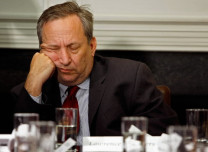From Lars Syll Even if interest-rate cuts at all points proximately increase demand, there are substantial grounds for concern if this effect is weak. It may be that any short-run demand benefit is offset by the adverse effects of lower rates on subsequent performance … From a macro perspective, low interest rates promote leverage and asset bubbles by reducing borrowing costs and discount factors, and encouraging investors to reach for yield. Almost every account of the 2008 financial crisis assigns at least some role to the consequences of the very low interest rates that prevailed in the early 2000s. More broadly, students of bubbles, from the economic historian Charles Kindleberger onward, always emphasize the role of easy money and overly ample liquidity. From a micro perspective,
Topics:
Lars Pålsson Syll considers the following as important: Uncategorized
This could be interesting, too:
tom writes The Ukraine war and Europe’s deepening march of folly
Stavros Mavroudeas writes CfP of Marxist Macroeconomic Modelling workgroup – 18th WAPE Forum, Istanbul August 6-8, 2025
Lars Pålsson Syll writes The pretence-of-knowledge syndrome
Dean Baker writes Crypto and Donald Trump’s strategic baseball card reserve
from Lars Syll
Even if interest-rate cuts at all points proximately increase demand, there are substantial grounds for concern if this effect is weak. It may be that any short-run demand benefit is offset by the adverse effects of lower rates on subsequent performance …
From a macro perspective, low interest rates promote leverage and asset bubbles by reducing borrowing costs and discount factors, and encouraging investors to reach for yield. Almost every account of the 2008 financial crisis assigns at least some role to the consequences of the very low interest rates that prevailed in the early 2000s. More broadly, students of bubbles, from the economic historian Charles Kindleberger onward, always emphasize the role of easy money and overly ample liquidity.
From a micro perspective, low rates undermine financial intermediaries’ health by reducing their profitability, impede the efficient allocation of capital by enabling even the weakest firms to meet debt-service obligations, and may also inhibit competition by favoring incumbent firms …
In moving toward the secular stagnation view, we have come to agree with the point long stressed by writers in the post-Keynesian (or, perhaps more accurately, original Keynesian) tradition: the role of particular frictions and rigidities in underpinning economic fluctuations should be de-emphasized relative to a more fundamental lack of aggregate demand …
What is needed are admissions of impotence, in order to spur efforts by governments to promote demand through fiscal policies and other means.
New ‘Keynesians’ — like Paul Krugman and Simon Wren-Lewis — have long been arguing that, at the zero lower bound of nominal interest rates, central bankers don’t have the tools to effectively fight recessionary tendencies in the economy. This yours truly and other Post Keynesian economists have criticized, arguing that those monetary measures don’t work even when we’re not even close to the zero lower bound.
In the New ‘Keynesian’ world we don’t need fiscal policy other than when interest rates hit their lower bound (ZLB). In normal times monetary policy suffices. The central banks simply adjust the interest rate to achieve full employment without inflation. If governments in that situation take on larger budget deficits, these tend to crowd out private spending and the interest rates get higher.
Now, the logic behind the New ‘Keynesians’ loanable-funds-IS-LM-theory is that if the government is going to pursue an expansionary fiscal policy it will have to borrow money and thereby increase the demand for loanable funds which will — “other things equal” — lead to higher interest rates and less private investment. According to this approach, the interest rate is endogenized by assuming that Central Banks can (try to) adjust it in response to an eventual output gap. This, of course, is essentially nothing but an assumption of Walras’ law being valid and applicable, and that a fortiori the attainment of equilibrium is secured by the Central Banks’ interest rate adjustments. From a Post Keynesian point of view, this is a belief resting on nothing but sheer hope.
We have to free ourselves from the loanable funds theory — and scholastic gibbering about ZLB — and start using good old Keynesian fiscal policies. Keynes — as did Lerner, Kaldor, Kalecki, and Robinson — showed that it was possible to promote economic growth with an “appropriate size of the budget deficit.” The stimulus a well-functioning fiscal policy aimed at full employment may have on investment and productivity does not necessarily have to be offset by higher interest rates.
 Now Larry Summers has come to realize that the New ‘Keynesian’ dogma is wrong and that we need other stabilisation (read fiscal) tools to get the economy going. That’s great. Now we’re eagerly awaiting some other guys to finely wake up …
Now Larry Summers has come to realize that the New ‘Keynesian’ dogma is wrong and that we need other stabilisation (read fiscal) tools to get the economy going. That’s great. Now we’re eagerly awaiting some other guys to finely wake up …
